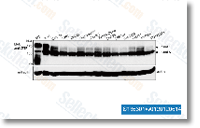These results suggest that, when in direct contact with fibroblasts, MDA MB 231 tumour cells were in a position to negatively regu late the expression of specific ECM components in CCD 1068SK fibroblasts, including CCN2 and kind I collagen. This regulation may well happen through up investigate this site regulation from the adverse regulator, Smad7. Tumour cells may very well be communicating with fibroblasts inside a paracrine manner by secreting soluble variables like cytokines and development things which can modulate Smad7, CCN2 and form I collagen gene expression in neighbouring fibroblasts by means of such secreted variables. To in vestigate this possibility, an indirect co culture technique was made use of in which CCD 1068SK fibroblasts were sepa rated in the MDA MB 231 tumour cells working with a transwell insert with a 0. two um pore size.
This permitted se creted components to pass through but prevented direct con tact amongst fibroblasts and tumour cells. Analysis of gene expression by quantitative genuine time RT PCR in indirectly co cultured CCD 1068SK EPZ-5676 Methyltransferase inhibitor fibroblasts revealed that tumour cells didn’t influence the expression of COL1A1, COL1A2, CCN2 or Smad7 when in comparison with fibroblast monocultures. In fact, Western Blot evaluation revealed that CCN2 protein levels have been in creased while Smad7 was decreased. These results recommend that tumour cell mediated regulation of Smad7, CCN2 and form I collagen expression in fibro blasts was dependent around the contacts with or close prox imity on the tumour cells to these fibroblasts.
Smad7 influences the expression of CCN2 and type I collagen gene expression To decide no matter whether the observed increase in Smad7 was connected with decreased CCN2  and type I collagen levels, Smad7 gene expression in CCD 1068SK fibroblasts was al tered by each gene silencing at the same time as transient overexpression. siRNA mediated knock down of Smad7 in fibroblasts resulted in a substantial raise in each CCN2 mRNA and protein levels when compared with controls. Although all Western Blots were performed below denaturing conditions, we observed the appearance of both monomeric and dimeric forms of CCN2 protein at 36 kDa and 72 kDa, respectively, having a precise raise in CCN2 dimerization in Smad7 knock down fibroblasts. The levels of 1 and 2 procollagen had been also in creased in Smad7 knock down fibroblasts in comparison with control fibroblasts, despite the fact that only COL1A1 levels appeared to be impacted at an mRNA level. Transfecting CCD 1068SK fibroblasts with the Smad7 overexpression plasmid pORF9 hSmad7 caused a considerable lower in CCN2, COL1A1 and COL1A2 mRNA levels, that is in agreement with the expression data shown in Figure 1A. While Smad7 protein levels were found to peak eight hours post transfection, the impact on CCN2 and form I collagen gene expression was only observed soon after 48 hours.
and type I collagen levels, Smad7 gene expression in CCD 1068SK fibroblasts was al tered by each gene silencing at the same time as transient overexpression. siRNA mediated knock down of Smad7 in fibroblasts resulted in a substantial raise in each CCN2 mRNA and protein levels when compared with controls. Although all Western Blots were performed below denaturing conditions, we observed the appearance of both monomeric and dimeric forms of CCN2 protein at 36 kDa and 72 kDa, respectively, having a precise raise in CCN2 dimerization in Smad7 knock down fibroblasts. The levels of 1 and 2 procollagen had been also in creased in Smad7 knock down fibroblasts in comparison with control fibroblasts, despite the fact that only COL1A1 levels appeared to be impacted at an mRNA level. Transfecting CCD 1068SK fibroblasts with the Smad7 overexpression plasmid pORF9 hSmad7 caused a considerable lower in CCN2, COL1A1 and COL1A2 mRNA levels, that is in agreement with the expression data shown in Figure 1A. While Smad7 protein levels were found to peak eight hours post transfection, the impact on CCN2 and form I collagen gene expression was only observed soon after 48 hours.
Related posts:
- These final results recommend that Akt is just not necessary for
- Seeing that no enormous grow in fibrob final numbers is observed
- It has been attributed to direct druginduced endothelial injury that results wit
- These final results indicate that the solid up regulation of IL
- All results confirm that emodin protected the liver from injury a
